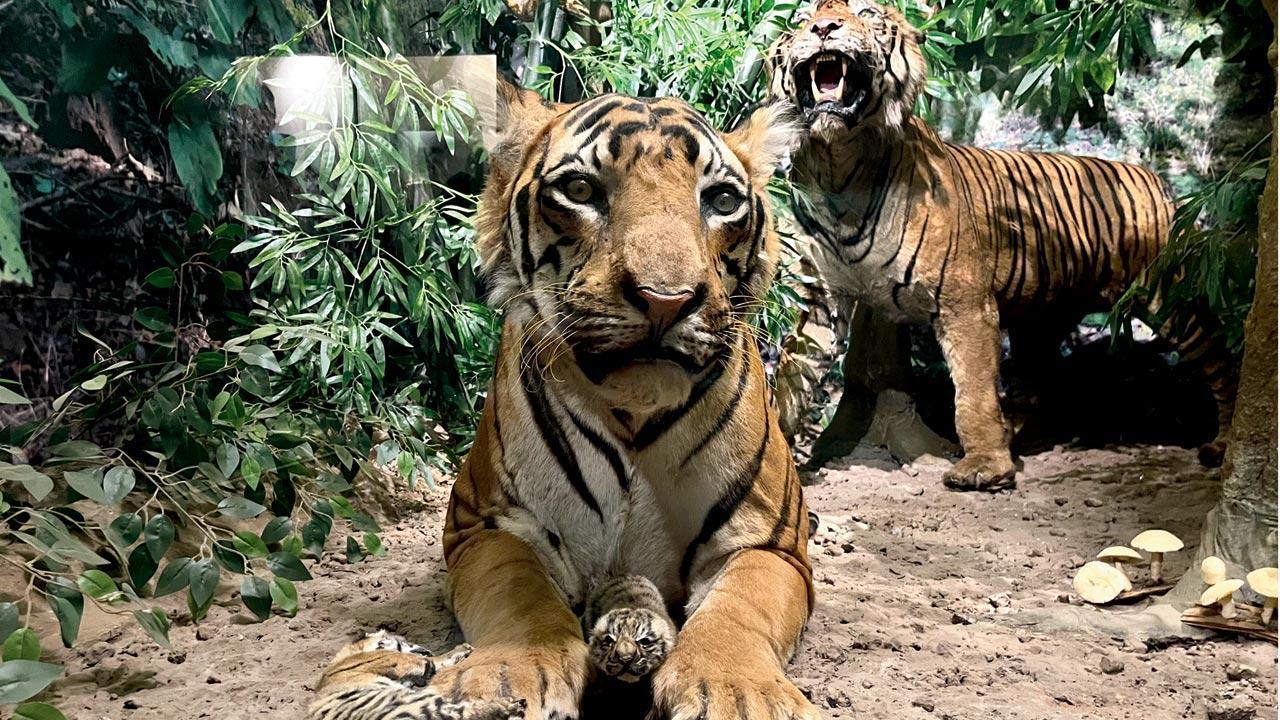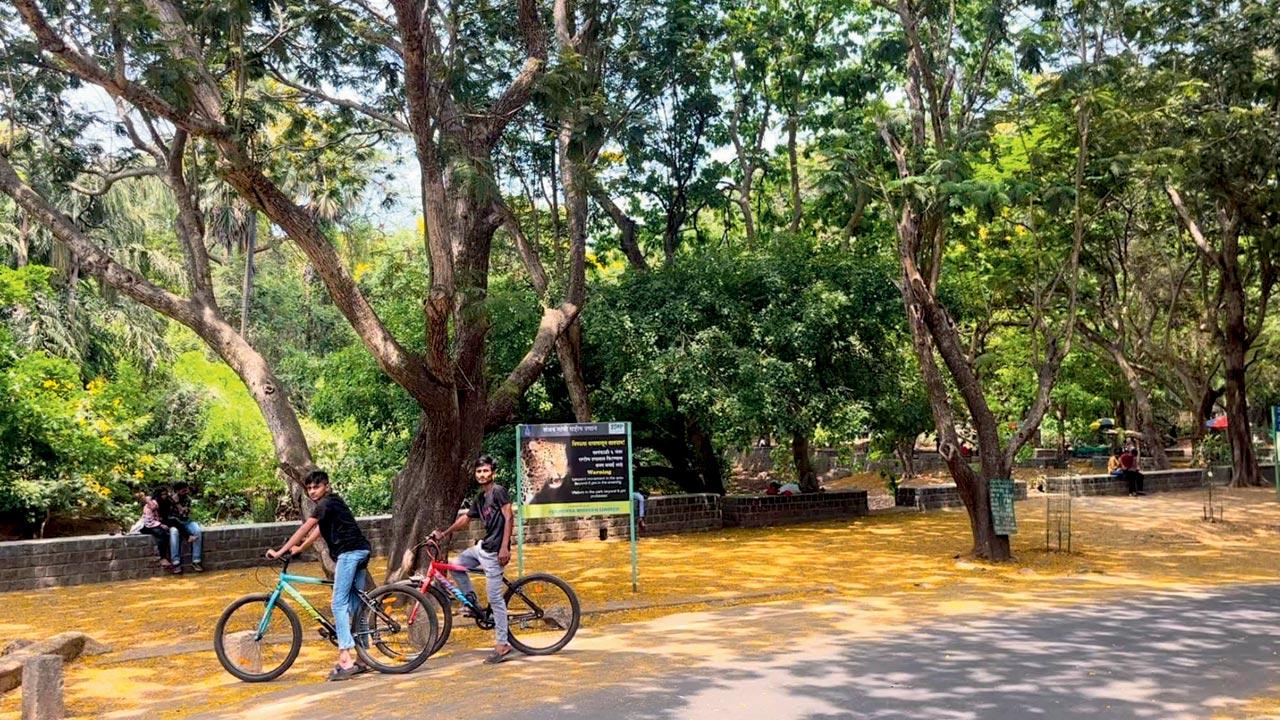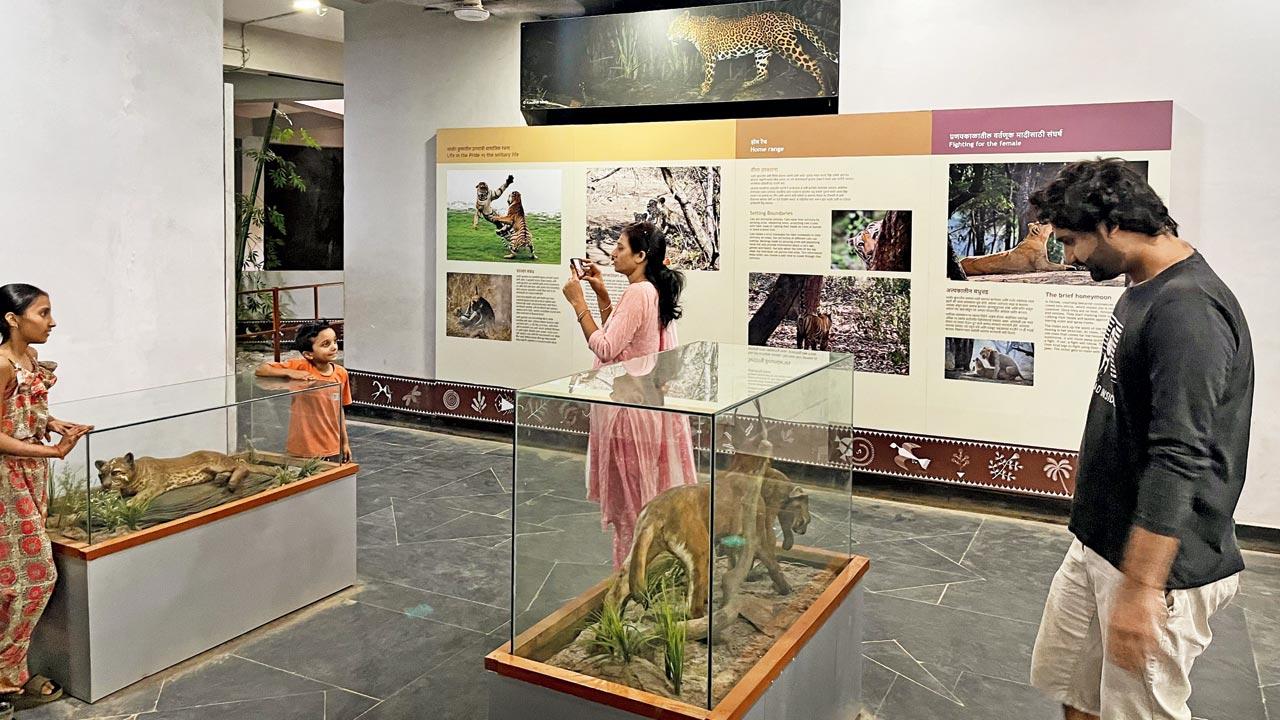A summer buggy tour organised by Sanjay Gandhi National Park offers a breezy exploration of a few tourist sites. We hop into one to check out how much of the wild side can be experienced on this short trail

An exhibit of a tiger and its cubs at the taxidermy centre. Pics/Devashish Kamble
On a weekend when Mumbaikars donned their trendiest costumes to grace the popular annual superhero convention in Bandra, the scenes at Sanjay Gandhi National Park (SGNP) in Borivali offered a different kind of convention in the outdoors. Like every weekend, it’s where naturalists and wildlife enthusiasts, armed with cameras and bicycles as their props, gather to explore the national park. Last Sunday, we joined their ranks by signing up for a summer buggy tour that promised an introduction to four unique tourist spots inside the park.
ADVERTISEMENT
We were greeted by a group of young cyclists making their way back from a tiring trail, evident from the exhaustion on their faces. Not far away, a fleet of eight parked buggies caught our eye. As we struck up a conversation with a driver about the 2.5 km-long ride and purchased a pass (R50 per adult), the buggy started filling with tourists like us. With six passengers on board, we rolled into the main area of the park.
 The buggy embarks on the trip
The buggy embarks on the trip
“Keep an eye out for wild animals. If it’s your lucky day, you might spot a deer,” the driver announced as we approached the half kilometer-mark on the trail. A kilometre, and no deer sightings later, we halted at the first stop — the Cat Orientation Centre. The driver showed us the way and instructed us to explore the museum and rendezvous at the entrance in 10 minutes.
The two storeyed viewing gallery is dotted with life-sized replicas of wild cats made using fibre. Paired with information panels on the walls, they introduced us to lesser-known wild cats such as the Eurasian lynx and the caracal. We were drawn to an installation that presents the distinct features of a wild cat like its whiskers, paws and claws in a dissected form. What makes a wild cat’s claw different from a domesticated cat, and what exactly do those whiskers even do? Just as we begin to delve into the answers, a loud whistle echoes in the room. It was time to move out. With the short 10-minute limit, and a plethora of information to take in, having to leave the space without fully exploring it might have been a writing on the wall we missed.
 Young cyclists take a break from their ride at the park
Young cyclists take a break from their ride at the park
Back in the buggy, the driver, trained in the basic workings of the tour, briefed us about the concept of taxidermy as we navigate the smooth, winding roads inside the park. For the uninitiated, the process involves skinning a dead animal, measuring its carcass to recreate it using fibre and finally, stretching the skin over it. The results of the tedious process are displayed at the Taxidermy Centre, our second halt. A guide at the centre walked us through the various exhibits. We learned that the skins are sourced from animals who die a natural death in national parks spread across India and then worked on by Dr Santosh Gaikwad, professor of anatomy, Bombay Veterinary College, Parel.
A guide within the space walked us through the collection of more than 200 exhibits, including a lion who infamously devoured an attendant and later died a natural death in the park. The walls are lined with birds ranging from sparrowhawks and the slaty-legged crake to the Indian cuckoo and peacocks. The newest addition to the collection, is a young spotted wildcat from the park. “Most visitors took a few selfies with these exhibits and left without enquiring deeper. We wished more people asked about the stories behind them,” our guide reveals, as we reached the end of the gallery.
 An installation of the Eurasian lynx
An installation of the Eurasian lynx
We walked out feeling a mix of intrigue, fascination and the heebie-jeebies. The next stops — the orchidarium and a fragrance garden — would be a pleasant change of scenery, we hoped. The excitement didn’t last longer than our ride to the next spot. The driver informed us that the two spots that usually house a vibrant sea of orchids and flowers are barren during this time of the year. This was a downer since both locations were clearly mentioned in the publicity material that we referred to before signing up for this buggy trail. It was a disappointing end as we reached the drop-off point of our ride that was a few metres away.
Later, we reached out to our fellow tourists for their verdict. A young consultant who was visiting the park for the first time voiced his concerns, “As a first-timer, I was a little lost at the gate and it was nice to have someone show you around. But I wish the stipulated time for viewing each spot was longer. A 10-minute exploration cannot suffice.” An older couple who’ve been regulars to the park for over a decade, echoed similar sentiments, “We wish the ride covered more areas. We were especially looking forward to the orchidarium. At best, this was a good respite from walking in the heat.”
Over a short call with Shubham Hadkar, nature education officer, SGNP, we learned that the orchidarium, while open to the public throughout the year, blooms during the monsoons. He assured that both the orchidarium and the fragrance garden will be a part of the tour as soon as late May. We learned that transparent covers can be attached to either side of the buggies, allowing them to remain functional during the monsoons. Hadkar suggested an alternative for tourists visiting earlier than the blooming season — a tiger and lion safari spread across 40 hectares of land that is open all year, and offers the opportunity to spot the big cats. With the anecdote of the taxidermised lion still fresh in our mind, we deem it an adventure fit for another day and sign off.
ON Tuesday to Sunday; 9 am to 5.30 pm
AT Sanjay Gandhi National Park, Borivali East.
CALL 7020141522 (for queries)
COST RS 94 (park entry fees); RS 50, (buggy pass for adults); RS 25 (kids below 12 years old)
Also check out
Sign up for these upcoming events for a fun exploration of the forest
Bombay #Runs: Join this close-knit community of foodies and runners who will be organising a run at the park on the last Sunday of every month.
ON April 28; 9.30 am
MEETING POINT Arundhati Bungalow, Krishna Nagar, Borivali East.
FREE
Cycle to Kanheri: Pedal through the green lanes of the park with this guided cycling tour that makes a halt at the 2nd century Buddhist caves.
TIME 7.15 am to 12 noon (daily)
LOG ON TO treksandtrails.org
COST Rs 699
Jambhulmal Trek: This beginner’s trek to the highest point in the national park will help you learn about unique species of plants.
TIME 6.30 am to 12.30 pm
LOG ON TO treksandtrails.org (dates available on request)
Salim Ali Point Trail: Learn the basics of birding at this guided trail to the Salim Ali Point.
ON April 28; 8 am
CALL 8591318027
ENTRY Rs 450 (members) Rs 550 (non-members)
Buggy tour guidebook
Dos:
. Stick to the route demarcated for the tour and avoid venturing into unknown trails alone
. Wear dull, earthy clothing and avoid wearing heavy accessories
. If you feel unwell, stop at one of the many protection huts in the park
. Consult a park attendant in case of unusual sightings or encounters
Don’ts:
. While photography is allowed, avoid using flash
. Do not feed the animals; allow them to forage for it on their own
. Avoid getting close to animals; it reduces the chances of sightings in the future
. Do not play loud music on your phone
 Subscribe today by clicking the link and stay updated with the latest news!" Click here!
Subscribe today by clicking the link and stay updated with the latest news!" Click here!







